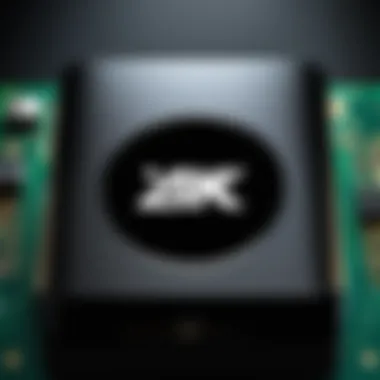Understanding HDMI 2.1's Impact on Xbox Series X Gaming


Overview of the Product
Purpose and Benefits
HDMI 2.1 introduces a range of capabilities that significantly enhance the gaming experience on the Xbox Series X. This technology supports higher resolutions, dynamic frame rates, and greater bandwidth, all of which translate to smoother visuals and a more immersive gameplay experience. With HDMI 2.1, gamers can appreciate the finer details of their games, thanks to features like 4K at 120 Hz and 8K at 60 Hz. Furthermore, variable refresh rate minimizes lag and screen tearing, creating a responsive and seamless interaction during gameplay.
Target Audience
The target audience for this technology includes tech enthusiasts, avid gamers, and computer builders looking to maximize their gaming setup. These individuals prioritize high-quality graphics, low latency, and enhanced performance. Understanding HDMI 2.1 is essential for those who want to stay ahead in the fast-evolving gaming landscape, especially with the growing demand for higher-frame-rate gaming.
Key Features
- Increased Bandwidth: Supports up to 48 Gbps, enabling higher resolutions and refresh rates.
- Variable Refresh Rate: Reduces lag and enhances motion clarity.
- Auto Low Latency Mode: Optimizes input delay for a more responsive gaming experience.
- Enhanced Audio Return Channel: Supports high-quality audio formats for an overall cinematic experience.
“HDMI 2.1 is not just an upgrade; it is a core component of next-level gaming.”
With these features at play, HDMI 2.1 provides the foundation for future gaming systems and media consumption, ensuring that users can truly capitalize on their Xbox Series X capabilities.
Understanding HDMI Technology
HDMI, or High-Definition Multimedia Interface, revolutionized the way we connect devices for audio and video transmission. It became especially relevant during the time when high-definition content gained prominence. Understanding this technology is crucial for any tech enthusiast or gamer interested in maximizing their experience. HDMI allows for the transfer of high-quality video and audio through a single cable, reducing clutter and making setup easier.
History of HDMI
The HDMI standard was first introduced in December 2002. The initial version, HDMI 1.0, supported resolutions up to 1080p and standard audio formats. Over the years, HDMI has evolved significantly. Each new version brought enhancements, allowing for higher resolutions, better audio formats, and new features like 3D support and Ethernet connectivity. The transition to HDMI 2.0 in 2013 marked a key moment as it enabled 4K streaming at 60 frames per second, catering to the increasing demand for Ultra HD content.
With HDMI 2.1, which came into the market in late 2017, the definition of high-quality connectivity was further expanded. This version supports a massive bandwidth of 48 Gbps, dynamic HDR, and variable refresh rates, paving the way for immersive gaming experiences. The evolution from HDMI 1.0 to HDMI 2.1 exemplifies how technology adapts to consumer needs and the rapidly changing landscape of media consumption.
What is HDMI 2.
?
HDMI 2.1 is a significant leap in connection technology. This new standard allows for a variety of enhancements that are essential for modern gaming and media consumption. With higher bandwidth capabilities, it supports resolutions up to 10K and refresh rates up to 120Hz at 4K, which is crucial for gamers who desire smoother motion and detailed visuals.
The following are some key features of HDMI 2.1:
- Dynamic HDR: This feature optimizes the contrast and color of each scene, enhancing the overall picture quality.
- Variable Refresh Rate (VRR): This allows the refresh rate of the display to synchronize with the frame rate output by the console, reducing lag and providing a more responsive gaming experience.
- Enhanced Audio Return Channel (eARC): eARC simplifies connectivity and supports higher audio quality, benefitting users with home theater setups.
Understanding these features helps gamers and tech enthusiasts appreciate the full potential of their devices, particularly when using consoles like the Xbox Series X.
Technical Specifications of HDMI 2.
HDMI 2.1 represents a significant leap in the world of digital interfaces, particularly for gaming consoles like the Xbox Series X. Understanding its technical specifications is crucial for any gamer or tech enthusiast seeking to optimize their experience. These advancements not only enhance visual and audio quality but also ensure the interface is suited for future developments in gaming technology.
Increased Bandwidth Capabilities
One of the most notable features of HDMI 2.1 is its increased bandwidth capabilities, allowing for a maximum throughput of 48 Gbps. This enhanced capacity supports higher resolutions and refresh rates, such as 8K at 60Hz or 4K at 120Hz. Gamers utilizing the Xbox Series X can fully realize the potential of their systems, enjoying smoother gameplay with minimal latency. The increased bandwidth is essential for delivering high-fidelity graphics and ensuring that images are rendered with precision.
Dynamic HDR Support
Dynamic HDR support is another critical component of HDMI 2.1. It allows for scene-by-scene or frame-by-frame adjustments of brightness, contrast, and colors, resulting in more lifelike visuals. This feature greatly enhances gaming experiences by providing better visibility in dark scenes, ensuring that players can identify details that would otherwise be obscured. The integration of this technology enables developers to create more immersive environments within games.


Variable Refresh Rate (VRR)
Variable Refresh Rate, or VRR, is designed to eliminate screen tearing and stuttering, which can disrupt gameplay. This feature synchronizes the refresh rate of the display with the frame rate output of the console, resulting in a smoother visual experience. For players invested in fast-paced games, such as first-person shooters, this means increased fluidity in the visual presentation, allowing for precise control and reaction times. Consequently, VRR significantly contributes to overall competitive performance.
Enhanced Audio Return Channel (eARC)
Enhanced Audio Return Channel (eARC) dramatically improves the audio experience for gamers. It allows for high-bitrate audio transmission, supporting formats like Dolby Atmos and DTS:X. As the Xbox Series X is capable of delivering immersive soundscapes, eARC ensures that every detail is transmitted clearly to compatible sound systems. This enhancement not only complements the visual quality but also supports a more engaging gaming environment, contributing to the overall immersion.
HDMI 2.1's technical specifications pave the way for advanced gaming experiences, making it a significant consideration for any passionate gamer with an Xbox Series X.
In essence, the technical specifications of HDMI 2.1 provide valuable enhancements for gaming. Each feature addressed forms a cohesive framework that allows gamers to harness the full potential of their consoles, creating a more satisfying and immersive experience.
Xbox Series X: A Gaming Powerhouse
The Xbox Series X stands as a testament to advancement in gaming technology. Developed by Microsoft, it delivers impressive specifications that redefine what gamers can expect from a console. Understanding its capabilities is important to appreciate the role HDMI 2.1 plays in enhancing the overall experience. This section dives into the key features of the Xbox Series X and how they contribute to its status as a gaming powerhouse.
Overview of Xbox Series Capabilities
The Xbox Series X boasts a powerful combination of hardware that sets it apart from previous generations. The console is powered by a custom AMD Ryzen processor, featuring eight cores and a high clock speed, which ensures seamless multitasking. Coupled with AMD's RDNA 2 architecture for graphics, it provides stunning visuals with ray tracing support.
Moreover, it comes equipped with 16 GB of GDDR6 RAM, allowing for fast data transfer and better overall performance. One of the key highlights is the SSD storage, which significantly reduces load times. The quick resume feature enables players to switch between multiple games with minimal lag.
The resolution output can reach up to 8K, offering breathtaking visuals for those with compatible displays. Furthermore, support for 120 frames per second allows for smooth and responsive gameplay, essential for competitive gaming. In essence, these capabilities make the console a top choice for avid gamers who seek high performance.
Game Library and Graphics Performance
The Xbox Series X offers an expansive library that showcases both current and next-gen titles. With access to thousands of games through the Xbox Game Pass, users can explore a variety of genres without additional purchases. This is an advantage for gamers who wish to try new titles regularly.
When we discuss graphics performance, the combination of RDNA 2 architecture and capabilities of HDMI 2.1 enhances the visual aspect remarkably. The graphics delivered can be both vibrant and nuanced, with details that engage players on a deeper level.
Additionally, features like Variable Refresh Rate minimize screen tearing, contributing to a smoother experience. HDR support ensures that colors are vivid and not washed out, enriching the overall gameplay.
In summary, the Xbox Series X combines advanced technology with a wide range of games. This synergy allows gamers to enjoy a truly captivating experience. The role of HDMI 2.1 in this scenario becomes even more critical, enabling the full potential of the console's capabilities.
The Role of HDMI 2.
in Xbox Series
HDMI 2.1 plays a crucial role in the functionality and performance of the Xbox Series X. Its advanced features address the demands of modern gaming. This section will explore key elements of HDMI 2.1 and how they enhance the user experience.
Maximizing Visual Quality
One of the standout features of HDMI 2.1 is its support for higher resolutions and refresh rates. Gamers can enjoy 4K resolution at 120 FPS, which leads to smoother gameplay and more vibrant visuals. This capability is especially important for fast-paced games where split-second reactions matter. The dynamic HDR support enhances color accuracy and contrast. This means scenes in games appear more realistic and immersive.
In addition, the increased bandwidth of HDMI 2.1 means that it can handle more data without compression. This helps maintain the quality of the visual output. With support for 8K at 60 FPS, this technology prepares gamers for future advancements, ensuring that the Xbox Series X remains relevant in an evolving gaming landscape.
"The advancements presented in HDMI 2.1 are not just upgrades; they are essential to fully experience what the Xbox Series X has to offer."
Optimizing Gaming Experience
HDMI 2.1 significantly enhances the overall gaming experience on the Xbox Series X. Features such as Variable Refresh Rate (VRR) and Auto Low Latency Mode (ALLM) contribute to a more responsive and fluid gaming environment. VRR reduces screen tearing, providing smoother frame transitions. This is particularly beneficial in competitive gaming scenarios where precision is key.


Moreover, ALLM automatically switches the display to low latency mode when a game is launched. This optimization ensures that latency is minimized, and gamers can focus entirely on their gameplay without delays. These advancements make a notable difference in competitive and casual gaming, thus making HDMI 2.1 a fundamental component of the Xbox Series X ecosystem.
Future-Proofing Gaming Systems
Investing in HDMI 2.1 is a forward-thinking choice for gamers who plan to upgrade their systems in the coming years. As gaming technology continues to evolve, the demands on hardware also increase. HDMI 2.1 supports features like higher resolutions, faster refresh rates, and dynamic resolutions in gaming, positioning itself as a necessary upgrade.
The capability to support future consoles and upcoming 8K games means that users won't have to replace their HDMI cables or displays as technology advances. By adopting HDMI 2.1 today, users ensure that their gaming systems remain capable and compatible in a dynamic market.
Compatibility Considerations
Understanding compatibility is crucial when dealing with HDMI 2.1 and the Xbox Series X. This section explores the practical implications of compatibility for users. Proper alignment between hardware and software ensures users can maximize the benefits of HDMI 2.1 technology. A lack of awareness in this area can lead to underwhelming gaming experiences.
Compatible Displays and Accessories
When investing in a gaming console like the Xbox Series X, ensuring compatibility with displays and accessories is essential. Not all TVs or monitors support HDMI 2.1, and gamers must pay attention to specific features that elevate the gaming experience.
- 4K at 120Hz: For optimal performance, the display should support 4K resolution at a refresh rate of at least 120Hz. This is significant for games that take advantage of high frame rates.
- Variable Refresh Rate (VRR): Many modern TVs include VRR technologies like AMD FreeSync or NVIDIA G-Sync, enhancing the visual experience by reducing tearing and stuttering during gameplay.
- HDMI 2.1 Port: It is fundamental to look for displays with dedicated HDMI 2.1 ports. Not all HDMI ports are the same, and only these can facilitate the advanced features of the new standard.
Accessories also play a role in compatibility. Choosing HDMI 2.1 certified cables and ensuring any external devices like soundbars support eARC is vital for a fully immersive gaming experience.
Cables and Connectivity Requirements
Cables and connectivity are often overlooked but are vital for harnessing HDMI 2.1's capabilities. The quality and type of cable can heavily influence performance. Therefore, it is important to be informed about these requirements.
- Certified HDMI 2.1 Cables: Using a HDMI 2.1 certified cable is non-negotiable. These cables can handle the increased bandwidth and provide the low latency gamers expect.
- Length of Cable: The length of the required cable can impact signal quality. For optimal performance, it is generally suggested to use shorter cables, particularly when gamers are connecting to displays farther away.
- Plug and Play Setup: Installing straight forward and intuitive as possible. The Xbox Series X and displays should recognize the HDMI connection automatically once everything is properly connected.
Ensuring the right setup and compatibility can significantly enhance the performance and experience of the Xbox Series X, providing smooth gameplay with stunning visuals and audio.
For detailed specifications, enthusiasts can refer to the Wikipedia HDMI page for comprehensive information.
Common Misconceptions about HDMI 2.
Understanding the common misconceptions about HDMI 2.1 is vital for both gamers and tech enthusiasts. These misconceptions often stem from a lack of knowledge or overgeneralization. Addressing these points can help clarify the actual advantages and applications of this technology in the context of the Xbox Series X.
Is HDMI 2.
Worth the Upgrade?
Many consumers ask whether upgrading to HDMI 2.1 is a justified investment. This question cannot be underestimated, as it dives into both practicality and performance. HDMI 2.1 offers substantial improvements in bandwidth, dynamic HDR, and enhanced audio capabilities compared to its predecessors.
Benefits of Upgrading:
- Higher Resolution Support: HDMI 2.1 is designed to support 8K resolution at up to 60 frames per second, with potential for 4K at higher refresh rates, which is particularly beneficial for the Xbox Series X.
- Variable Refresh Rates (VRR): This feature helps eliminate screen tearing and improves gaming performance, which can be a game changer in fast-paced titles.
- Enhanced Audio Return Channel (eARC): eARC allows for a higher quality audio experience, ensuring that sound quality matches visually stunning content.
For many gamers using the Xbox Series X, the upgrade may well be worth it. However, it’s important to check if your display and cables can also handle the new specifications.
Debunking Myths and Misinformation
A significant amount of misinformation exists surrounding HDMI 2.1. This can lead to misunderstanding its features and capabilities. Here are some common myths:
- Myth: HDMI 2.1 is only for 8K Gaming
- Myth: All HDMI Cables Can Handle HDMI 2.1
- Myth: HDMI 2.1 Is Overkill for Current Gaming


- While HDMI 2.1 does excel in delivering 8K content, it also enhances 4K gaming. Many titles on Xbox Series X will benefit from the features of HDMI 2.1 without needing an 8K display.
- This is incorrect. Not all HDMI cables are capable of supporting the higher bandwidth required by HDMI 2.1. Users must look for Ultra High Speed HDMI cables to ensure full functionality.
- While some might view the features as excessive for current games, the landscape of gaming technology is rapidly evolving. HDMI 2.1 can provide a form of future-proofing for new game releases and evolving consoles.
By clarifying these misconceptions, gamers can make informed choices regarding their equipment and ensure they are maximizing their Xbox Series X experience with HDMI 2.1.
Maximizing Performance with HDMI 2.
Maximizing performance with HDMI 2.1 is crucial for gamers and tech enthusiasts looking to harness the full capabilities of the Xbox Series X. The introduction of HDMI 2.1 has brought forth various advancements that significantly enhance both visual quality and overall gaming experience. Understanding these features can help users optimize their setup and ensure they are not missing out on what this technology has to offer.
One of the most significant benefits of HDMI 2.1 is its ability to support 4K at high refresh rates, allowing for smoother gameplay. This technology is particularly relevant for competitive gamers who require the fastest response times and the clearest visuals. Moreover, features like Variable Refresh Rate (VRR) and Auto Low Latency Mode (ALLM) further enhance the gaming experience by reducing screen tearing and lag.
Optimal Settings for Xbox Series
To truly maximize the performance of your Xbox Series X through HDMI 2.1, it is important to adjust certain settings. First, ensure that your console is set to output the highest resolution available on your display. This can usually be done through the settings menu under the 'General' tab. Select 'TV & display options' and set the resolution to 4K.
Next, enable the 120Hz refresh rate option if your display supports it. This is particularly important for gamers who wish to make the most of fast-paced action games. The 'Game Mode' on your TV should also be activated to minimize input lag.
Lastly, look for options related to VRR and ALLM in both the console settings and your TV settings. These features should be enabled to ensure the best possible synchronization between your console and display.
Troubleshooting Common Issues
Even with the best equipment, users may encounter issues when using HDMI 2.1 with their Xbox Series X. A common problem is the inability to achieve the desired resolution or refresh rate. If this occurs, first check the compatibility of your HDMI cable and ensure it meets the required specifications for HDMI 2.1.
Another issue could be related to the TV settings. Sometimes, features like VRR or ALLM may be disabled or not properly configured in the TV's settings menu. It is advised to consult the TV's user manual to locate these options.
In some cases, connectivity problems can arise. If your console and display are not communicating correctly, plugging the HDMI cable into a different port may resolve the issue, as some TVs have specific ports that support advanced features.
If problems persist, consider reaching out to the customer support teams for your console or TV manufacturer. They may have updates or solutions tailored to your specific situation.
Overall, maximizing performance with HDMI 2.1 requires a combination of optimal settings and troubleshooting practices to ensure a seamless gaming experience on the Xbox Series X.
The Future of Gaming Interfaces
As technology evolves, so does the interface through which we interact with our gaming systems. The future of gaming interfaces is a critical discussion, especially in the context of advancements like HDMI 2.1 and its applications in devices like the Xbox Series X. This section delves into emerging trends and the next generations of HDMI standards that aim to enhance the overall gaming experience.
Emerging Trends in Gaming Technology
The gaming landscape is changing rapidly. As gamers demand more immersive experiences, technology must adapt. One emerging trend is the integration of higher resolutions and refresh rates. Many gamers are now gravitating toward 4K and 8K displays. HDMI 2.1 supports these resolutions, allowing for sharp visuals and smooth gameplay.
Alongside this, technologies like ray tracing are becoming more common. This feature brings realistic lighting and shadows to games. HDMI 2.1 can convey the necessary data at high frequencies without lag, enhancing overall visual fidelity.
Additionally, the adoption of cloud gaming platforms is gaining traction. Services such as Xbox Cloud Gaming enable playing anywhere. However, a robust interface is required to maintain high-quality streams. HDMI 2.1 is designed to handle such data-intensive tasks effectively, ensuring that players receive a seamless experience even over complex cloud infrastructures.
The Next Generations of HDMI Standards
Looking beyond HDMI 2.1, the future promises even more advancements. Those anticipated standards may provide further enhancements in bandwidth and resolutions. For instance, HDMI 2.2 aims to offer even higher bandwidth, possibly supporting 16K resolution. This step would be in line with growing demand for higher graphical performance across gaming and multimedia activities.
Furthermore, the push for better audio fidelity is another focus. As gaming becomes more immersive, audio quality significantly enhances player experience. Enhanced Audio Return Channel (eARC) will likely evolve, allowing for uncompressed audio formats, making soundscapes richer and more engaging.
Another important aspect is variable refresh rates. Future HDMI versions might take this feature further, enabling flawlessly synchronized frame rates across multiple devices, which is crucial for competitive gaming.
As HDMI technology progresses, it directly influences how gamers interact with and enjoy their games. Enhanced interfaces pave the way for more dynamic and immersive experiences that were not previously possible.
In summary, the future of gaming interfaces is centered around enhancing visual and audio capabilities. The integration of HDMI 2.1 in devices like the Xbox Series X marks only the beginning. With ongoing innovations, gamers can expect increasingly sophisticated systems that transform their gaming experiences.



